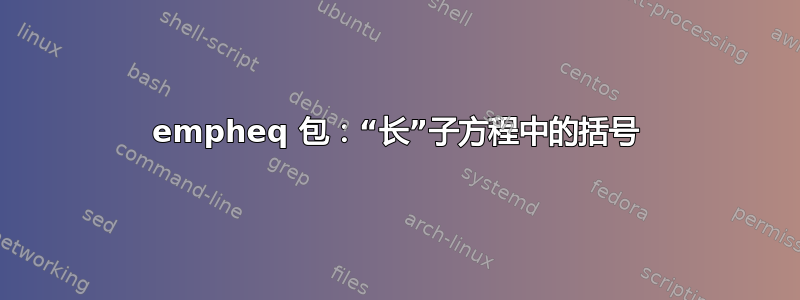
我正在使用这个问题的答案子方程中的括号但是我的方程太长,并且方程编号失败,如 MWE 所示(根据问题中给出的 MWE 修改而来)。
我正在寻找一种解决方法:通常当一个等式太长时,数字会放在下面的一行中,但是要逐个等式地进行,而不是像这里一样针对整个方程。

\documentclass{article}
\usepackage{empheq}
\begin{document}
\begin{subequations}
\begin{empheq}[left=\empheqlbrace]{align}
x & = y + z\\
a^{2} & = b^{2} + c^{2} + c^{2} + c^{2} + c^{2} + c^{2} + c^{2} + c^{2} + c^{2} + c^{2} + c^{2} + c^{2} + c^{2} + c^{2} + c^{2}
\end{empheq}
\end{subequations}
\end{document}
答案1
在我看来,这是一个可以有效打破长线局面的案例。
\documentclass{article}
\usepackage{empheq}
\begin{document}
\begin{subequations}
\begin{empheq}[left=\empheqlbrace]{align}
x & = y + z\\
a^{2} & = \begin{aligned}[t]
& b^{2} + c^{2} + c^{2} + c^{2} + c^{2} + c^{2} + c^{2} \\
& + c^{2} + c^{2} + c^{2} + c^{2} + c^{2} + c^{2} + c^{2} + c^{2}
\end{aligned}
\end{empheq}
\end{subequations}
\end{document}
编辑
这是在最后一行有第二个方程编号的版本。它更加人为,并且没有保持逻辑结构(因此它会不是如果从代码来看,它可以成为屏幕阅读器的一个很好的模型,但打印出来看起来还不错。
\documentclass[tbtags]{article}
\usepackage{empheq}
\begin{document}
\begin{subequations}
\begin{empheq}[left=\empheqlbrace]{align}
x & = y + z\\
a^{2} & = b^{2} + c^{2} + c^{2} + c^{2} + c^{2} + c^{2} + c^{2} \notag \\
& \phantom{{}={}} + c^{2} + c^{2} + c^{2} + c^{2} + c^{2} + c^{2} + c^{2} + c^{2}
\end{empheq}
\end{subequations}
\end{document}
答案2
像往常一样,我希望能够理解您的请求。我已经\ \从初始代码中删除了双倍。我曾经\usepackage[margin=2cm]{geometry}减小过纸张大小的边距。查看屏幕截图,看看是否没问题。
\documentclass[12pt]{article}
\usepackage[margin=2cm]{geometry}
\usepackage{amsmath}
\usepackage{empheq}
\begin{document}
\begin{subequations}
\begin{empheq}[left=\empheqlbrace]{align}
x & = y + z\\
a^{2} & = b^{2} + c^{2} + c^{2} + c^{2} + c^{2} + c^{2} + c^{2} + c^{2} + c^{2} + c^{2} + c^{2} + c^{2} + c^{2} + c^{2} + c^{2}
\end{empheq}
\end{subequations}
\end{document}
答案3
使用witharrows,您可能会得到以下结果,但这并不令人满意:
\documentclass{article}
\usepackage{witharrows}
\usepackage{amsmath}
\usepackage{lipsum}
\begin{document}
\lipsum[1]
%
\begin{DispWithArrows}<>[subequations]
x & = y + z\\
a^{2} & = b^{2} + c^{2} + c^{2} + c^{2} + c^{2} + c^{2} + c^{2} + c^{2} + c^{2} + c^{2} + c^{2} + c^{2} + c^{2} +
c^{2} + c^{2}
\tagnextline
\end{DispWithArrows}
\end{document}






